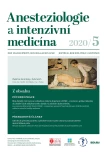Low volume distal sciatic block (LVDSB) – comparison spread of injectate between LVSDB and distal adductor canal in healthy volunteer
Authors:
D. Nalos; Ľ. Beňo; D. Bejšovec
Authors‘ workplace:
Klinika anesteziologie, perioperační a intenzivní medicíny Univerzita J. E. Purkyně v Ústí nad Labem, Masarykova, nemocnice v Ústí nad Labem
Published in:
Anest. intenziv. Med., 31, 2020, č. 5, s. 206-211
Category:
Original Article
Overview
Study objective: The aim of the study is to compare two different approaches to the blockade of the popliteal area by evaluating the distribution of an aqueous solution of salt in one volunteer.
Type of study: Short technical report.
Site type: Department of Anesthesiology, Perioperative and Intenzive Medicine.
Material and method: In a volunteer, we simulated two alternative regional blocks, simultaneously, one on each lower limb. On the left leg a simulation of the low volume block of the distal part of the sciatic nerve (LVDSB) was performed by applying 6 ml of 0.9% NaCl solution. Subsequently, on the right leg, simulation of the distal adductor canal block was performed by applying 20 ml of the same solution. Immediately after application CT scans of both popliteal areas including 3D reconstruction was performed.
Results: The analysis of distribution of the solution, by means of computed tomography, after application of a low-volume block (6 ml) to the distal part of the sciatic nerve (LVDSB) shows the spread of fluid to the area of genicular nerves originating from the sciatic nerve. The fluid applied to the distal part of the adductor canal tends to predominantly penetrate retrograde into the thigh area. In the distal direction, the fluid is spreading both along n. saphenus and in medial direction, where it reached the inner edge of the vascular bundle between the adductors. However, it does not spread to the space where genicular branches originate from the sciatic, tibial and fibular nerves.
Conclusion: After LVDSB, the distribution of local anesthetic to the genicular nerve region of the sciatic nerve occurs. The aqueous solution administered through the distal end of the adductor canal does not cover the entire area of the “popliteal” plexus and is unlikely to be able to provide a comparable level of analgesia.
Keywords:
regional anesthesia – popliteal fossa – ultrasound
Sources
1. Kardash KJ, Noel GP. The SPANK Block: A Selective Sensory, Single-Injection Solution for Posterior Pain after Total Knee Arthroplasty Reg Anesth Pain Med 2016 : 41 : 118–119.
2. Runge Ch, Moriggl B, Børglum J, Fichtner Bendtsen T. The Spread of Ultrasound-Guided Injectate From the Adductor Canal to the Genicular Branch of the Posterior Obturator Nerve and the Popliteal Plexus A Cadaveric Study. Reg. Anest Pain Med 2017; 42(6): 725–730.
3. Tran J, Giron Arango L, Peng P, Sinha SK, Agur A, Chan V. Evaluation of iPACK block injectate spread: a cadaveric study. Reg Anest Pain Med 2019; 44(7): 689–694.
4. Kampitak W, Tanavalle A, Ngarmukos S, Tantavisut S. Motor-sparing effect of iPACK (interspace between the popliteal artery and capsulae of the posterior knee) block versus tibial nerve block after total knee artroplasty: a randomized controlled study. Reg Anest Pain Med 2020; 45(4): 267–276.
5. Conger A, Cushman DM, Walker K, Petersen R, Walega DR, Kendall R, et al. A Novel Technical Protocol for Improved Capture of the Genicular Nerves by Radiofrequency Ablation Pain Medicine 2019; 20(11): 2208–2212.
6. Fonkoué L, Behets C, Kouassi JÉK, Coyette M, Detrembleur Ch, Thienpont E, et al. Distribution of sensory nerves supplying the knee joint capsule and implications for genicular blockade and radiofrequency ablation: an anatomical study. Surgical and Radiologic Anatomy 2019; 41(12): 1461–1471.
7. Büttner B, Schwarz A, Mewes C, Kristof K, Hinz J, Quintel M, et al. Subparaneural injection in popliteal sciatic nerve blocks evaluated by MRI. Open Medicine 2019; 14(1): 346–353.
8. De Tran QH, González AP, Bernucci F, Pham K, Finlayson RJ. A Randomized Comparison Between Bifurcation and Prebifurcation Subparaneural Popliteal Sciatic Nerve Blocks. Anesth Analg 2013; 116(5): 1170–1175.
9. Vloka JD, Hadzić A, Lesser JB, Kitain E, Geatz H, April EW, et al. A Common Epineural Sheath for the Nerves in the Popliteal Fossa and Its Possible Implications for Sciatic Nerve Block. Anesth Analg 1997; 84(2): 387–390.
10. Abdallah FW, Chan VW. The Paraneural Compartment A New Destination? Reg Anest Pain Med. 2013; 38(5): 375–376.
11. Reina MA, De Andrés JA, Hadzic A, Prats-Galino A, Sala-Blanch X, van Zundert AAJ. Atlas of Functional Anatomy for Regional Anesthesia and Pain Medicine. 2015.
12. Gustafson KJ, Grinberg Y, Joseph S, Triolo RJ. Human distal sciatic nerve fascicular anatomy: Implication for ancle control using nerve cuff electrodes. JRRD 2012; 49(2): 309–322.
13. Cappelleri G, Ambrosoli AL, Gemma M, Cedrati VLE, Bizzarri F, Danelli GF. Intraneural Ultrasound-guided Sciatic Nerve Block Minimum Effective Volume and Electrophysiologic Effects Anesthesiology 2018; 129(2): 241–248.
14. Perlas A, Wong P, Abdallah F, Hazrati L-N, Tse C, Chan V. Ultrasound-Guided Popliteal Block Through a Common Paraneural Sheath Versus Conventional Injection. A Prospective, Randomized, Double-blind Study. Reg Anesth Pain Med 2013; 38(3): 218–225.
Labels
Anaesthesiology, Resuscitation and Inten Intensive Care MedicineArticle was published in
Anaesthesiology and Intensive Care Medicine

2020 Issue 5
Most read in this issue
- Use of rotational thromboelastometry in perioperative medicine and its comparison with standard coagulation testing
- Refusal of patient admission from pre-hospital care by the provider of acute inpatient care
- The importance and options of peroperative evaluation of nociception
- Fentanyl – 60 years since synthesis, history of opioid analgesics
